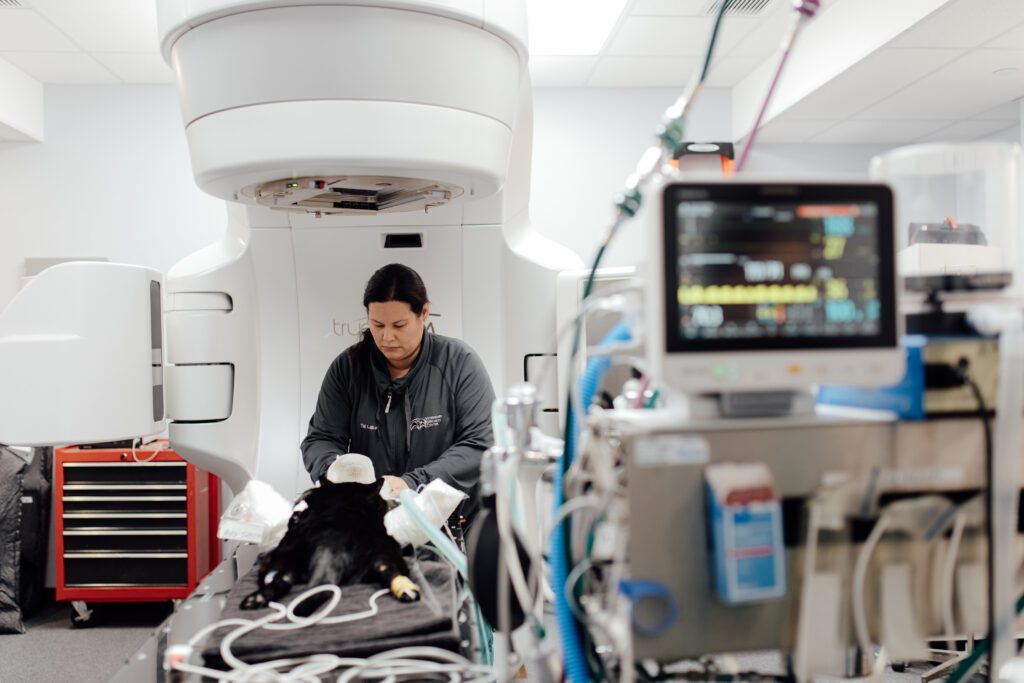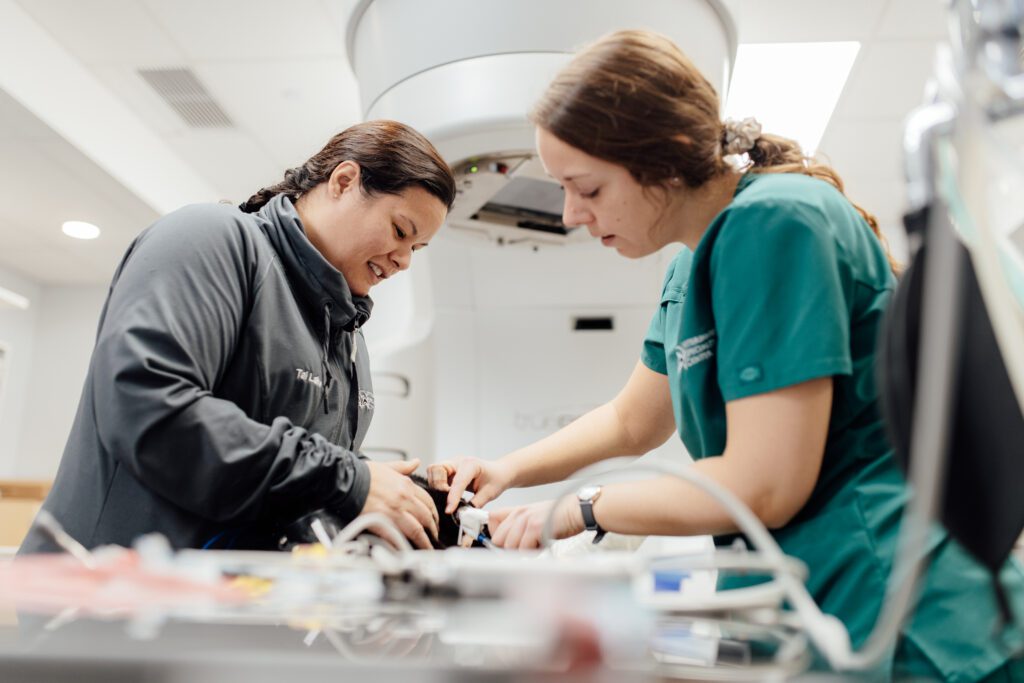Radiation Therapy – Squamous Cell Carcinoma in Cats
 Squamous cell carcinoma (SCC) is a cancer of skin cells called keratinocytes in cats, accounting for 15% of all cat skin tumors and 60-70% of all cat oral tumors. They typically arise in cats 10 years of age and older, and are most commonly found on the face in regions of light-colored fur or inside the oral cavity. Exposure to UV radiation from the sun is thought to play a role in the development of SCC on the furred skin areas, but not for tumors that develop inside the mouth. Over 90% of oral SCC in cats are malignant, locally invasive and destructive of surrounding bone, which can be painful. The most common locations of oral SCC in cats are the sublingual/lingual region, maxilla, mandible, buccal mucosa, lip, and caudal pharynx/tonsillar region. Spread to other parts of the body (metastasize) occurs in 30-40% of patients.
Squamous cell carcinoma (SCC) is a cancer of skin cells called keratinocytes in cats, accounting for 15% of all cat skin tumors and 60-70% of all cat oral tumors. They typically arise in cats 10 years of age and older, and are most commonly found on the face in regions of light-colored fur or inside the oral cavity. Exposure to UV radiation from the sun is thought to play a role in the development of SCC on the furred skin areas, but not for tumors that develop inside the mouth. Over 90% of oral SCC in cats are malignant, locally invasive and destructive of surrounding bone, which can be painful. The most common locations of oral SCC in cats are the sublingual/lingual region, maxilla, mandible, buccal mucosa, lip, and caudal pharynx/tonsillar region. Spread to other parts of the body (metastasize) occurs in 30-40% of patients.
Treatments are focused on local control of the tumor and clinical signs. Surgery is the first-line treatment if the mass is still small enough that complete excision is possible. Very commonly, that is not the case with these tumors. If a tumor is not completely removed, tumors grew back within 5-12 months in 35-80% of patients. Even a small number of tumors that were thought to be completely removed will grow back. Overall, the survival times for cats that received surgery alone for oral SCC is <6 months. Individual cases may do better and a consultation with a surgeon is recommended. Most cats recover well following surgery, however, one study cites that 12% of cats who underwent mandibulectomy (removed a portion of the lower jaw) for treatment of oral tumors never regained the ability to eat or drink.
The combination of surgery and radiation has been attempted to lower this high recurrence rate. The radiation is applied 2 weeks after the surgery to allow for healing and is then delivered in small, daily (or twice daily) doses for 15-20 days, Monday through Friday. Each dose of radiation is performed while the patient is lightly anesthetized. This combination cites the longest survival times, some studies reporting up to 14 months of tumor control, and tumors on the lower jaw (mandible) doing the best. In addition, there is a period of acute radiation side effects with these daily, fractionated radiation protocols to the oral mucosa, skin, eyes, and nasal cavity. These are transient, beginning 2-3 weeks into a protocol and resolving 2-3 weeks after completion of radiation, however, they themselves are painful and are managed with oral pain medications, antibiotics, and/or sometimes feeding tubes when patients refuse to eat due to the oral discomfort.
 Hypofractionated (meaning a low number of treatments), palliative radiation protocols are the most common treatments elected for oral SCC in cats because of the aggressive nature of the disease. They have a low risk of acute radiation side effects and are excellent at alleviating oral pain and inflammation. These protocols are abbreviated daily doses (for 5-10 doses) or once a week for 4-6 weeks. Tumor control ranges from 2-4 months in most patients, with good quality of life during that time. Chemotherapy has been tried in combination with radiation as well and may help extend tumor control. Unfortunately, the evidence for this is weak at this time. Chemotherapy alone has been unrewarding for local tumor control.
Hypofractionated (meaning a low number of treatments), palliative radiation protocols are the most common treatments elected for oral SCC in cats because of the aggressive nature of the disease. They have a low risk of acute radiation side effects and are excellent at alleviating oral pain and inflammation. These protocols are abbreviated daily doses (for 5-10 doses) or once a week for 4-6 weeks. Tumor control ranges from 2-4 months in most patients, with good quality of life during that time. Chemotherapy has been tried in combination with radiation as well and may help extend tumor control. Unfortunately, the evidence for this is weak at this time. Chemotherapy alone has been unrewarding for local tumor control.
Most cats succumb to the local progression of their disease (tumor grows back or bony destruction in the region leads to fistulas, infections or fractured bones) before metastasis has a chance to become clinically relevant. If the cat has a good response to local treatment for 6-12 months, common locations for metastasis include the regional lymph nodes and the lungs.
Thank you for considering bringing your pet to us for treatment. We understand and value the trust you have placed in us. Should you have any questions regarding radiation therapy for the treatment of your pet’s tumor, please do not hesitate to ask to be put in contact with a member of our radiation oncology team. We would be happy to spend time making sure you have all the information required to make an informed decision with regard to the treatment of your pet.
